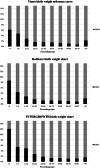Associations of severe adverse perinatal outcomes among continuous birth weight percentiles on different birth weight charts: a secondary analysis of a cluster randomized trial
- PMID: 35490210
- PMCID: PMC9055757
- DOI: 10.1186/s12884-022-04680-5
Associations of severe adverse perinatal outcomes among continuous birth weight percentiles on different birth weight charts: a secondary analysis of a cluster randomized trial
Abstract
Objective: To identify neonatal risk for severe adverse perinatal outcomes across birth weight centiles in two Dutch and one international birth weight chart.
Background: Growth restricted newborns have not reached their intrinsic growth potential in utero and are at risk of perinatal morbidity and mortality. There is no golden standard for the confirmation of the diagnosis of fetal growth restriction after birth. Estimated fetal weight and birth weight below the 10th percentile are generally used as proxy for growth restriction. The choice of birth weight chart influences the specific cut-off by which birth weight is defined as abnormal, thereby triggering clinical management. Ideally, this cut-off should discriminate appropriately between newborns at low and at high risk of severe adverse perinatal outcomes and consequently correctly inform clinical management.
Methods: This is a secondary analysis of the IUGR Risk Selection (IRIS) study. Newborns (n = 12 953) of women with a low-risk status at the start of pregnancy and that received primary antenatal care in the Netherlands were included. We examined the distribution of severe adverse perinatal outcomes across birth weight centiles for three birth weight charts (Visser, Hoftiezer and INTERGROWTH) by categorizing birth weight centile groups and comparing the prognostic performance for severe adverse perinatal outcomes. Severe adverse perinatal outcomes were defined as a composite of one or more of the following: perinatal death, Apgar score < 4 at 5 min, impaired consciousness, asphyxia, seizures, assisted ventilation, septicemia, meningitis, bronchopulmonary dysplasia, intraventricular hemorrhage, periventricular leukomalacia, or necrotizing enterocolitis.
Results: We found the highest rates of severe adverse perinatal outcomes among the smallest newborns (< 3rd percentile) (6.2% for the Visser reference curve, 8.6% for the Hoftiezer chart and 12.0% for the INTERGROWTH chart). Discriminative abilities of the three birth weight charts across the entire range of birth weight centiles were poor with areas under the curve ranging from 0.57 to 0.61. Sensitivity rates of the various cut-offs were also low.
Conclusions: The clinical utility of all three charts in identifying high risk of severe adverse perinatal outcomes is poor. There is no single cut-off that discriminates clearly between newborns at low or high risk.
Trial registration: Netherlands Trial Register NTR4367 . Registration date March 20th, 2014.
Keywords: Birth weight reference charts; Birth weight reference curve; Birth weight standard; FGR; Fetal growth restriction; Growth restriction in the newborn; IUGR; SGA; Small for gestational age.
© 2022. The Author(s).
Conflict of interest statement
The authors report no competing interests.
Figures
Similar articles
-
Determination of birth-weight centile thresholds associated with adverse perinatal outcomes using population, customised, and Intergrowth charts: A Swedish population-based cohort study.PLoS Med. 2019 Sep 20;16(9):e1002902. doi: 10.1371/journal.pmed.1002902. eCollection 2019 Sep. PLoS Med. 2019. PMID: 31539391 Free PMC article.
-
Performance of six birth-weight and estimated-fetal-weight standards for predicting adverse perinatal outcome: a 10-year nationwide population-based study.Ultrasound Obstet Gynecol. 2021 Aug;58(2):264-277. doi: 10.1002/uog.22151. Ultrasound Obstet Gynecol. 2021. PMID: 32672406
-
Effectiveness of routine third trimester ultrasonography to reduce adverse perinatal outcomes in low risk pregnancy (the IRIS study): nationwide, pragmatic, multicentre, stepped wedge cluster randomised trial.BMJ. 2019 Oct 15;367:l5517. doi: 10.1136/bmj.l5517. BMJ. 2019. PMID: 31615781 Free PMC article. Clinical Trial.
-
The World Health Organization fetal growth charts: concept, findings, interpretation, and application.Am J Obstet Gynecol. 2018 Feb;218(2S):S619-S629. doi: 10.1016/j.ajog.2017.12.010. Am J Obstet Gynecol. 2018. PMID: 29422204 Review.
-
[Review of the literature on intrauterine and birthweight charts].Gynecol Obstet Fertil Senol. 2023 May;51(5):256-269. doi: 10.1016/j.gofs.2022.09.014. Epub 2022 Oct 24. Gynecol Obstet Fertil Senol. 2023. PMID: 36302475 Review. French.
Cited by
-
On the study of fetal growth restriction: time to abandon SGA.Eur J Epidemiol. 2024 Mar;39(3):233-239. doi: 10.1007/s10654-024-01098-5. Epub 2024 Mar 2. Eur J Epidemiol. 2024. PMID: 38429604 No abstract available.
-
Inferring fetal growth restriction as rare, severe, and stable over time.Eur J Epidemiol. 2023 May;38(5):455-464. doi: 10.1007/s10654-023-00985-7. Epub 2023 Apr 13. Eur J Epidemiol. 2023. PMID: 37052754 Free PMC article.
-
Perinatal mortality rate and adverse perinatal outcomes presumably attributable to placental dysfunction in (near) term gestation: A nationwide 5-year cohort study.PLoS One. 2023 May 4;18(5):e0285096. doi: 10.1371/journal.pone.0285096. eCollection 2023. PLoS One. 2023. PMID: 37141189 Free PMC article.
-
Maternal and neonatal outcomes of pregnancies after metabolic bariatric surgery: a retrospective population-based study.Lancet Reg Health Eur. 2025 Mar 22;51:101263. doi: 10.1016/j.lanepe.2025.101263. eCollection 2025 Apr. Lancet Reg Health Eur. 2025. PMID: 40213500 Free PMC article.
-
Association between perinatal mortality and morbidity and customised and non-customised birthweight centiles in Denmark, Finland, Norway, Wales, and England: comparative, population based, record linkage study.BMJ Med. 2023 Aug 30;2(1):e000521. doi: 10.1136/bmjmed-2023-000521. eCollection 2023. BMJ Med. 2023. PMID: 37663045 Free PMC article.
References
-
- Frøen JF, Gardosi JO, Thurmann A, Francis A, Stray-Pedersen B. Restricted fetal growth in sudden intrauterine unexplained death. Acta Obstet Gynecol Scand. 2004;83(9):801–807. - PubMed
-
- Pels A, Knaven OC, Wijnberg-Williams BJ, Eijsermans MJC, Tollenaer SMM, Aarnoudse-Moens CSH, et al. Neurodevelopmental outcomes at five years after early-onset fetal growth restriction: Analyses in a Dutch subgroup participating in a European management trial. Eur J Obstet Gynecol Reprod Biol. 2019;234:63–70. doi: 10.1016/j.ejogrb.2018.12.041. - DOI - PubMed
Publication types
MeSH terms
LinkOut - more resources
Full Text Sources
Miscellaneous


